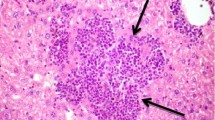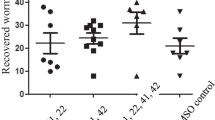Abstract
Wuchereria bancrofti is the main species responsible for human lymphatic filariasis and remains a major public health problem in tropical countries around the world. Diethylcarbamazine (DEC) has been used for decades in control programs as an effective microfilaricide, although its efficacy in killing adult worms is only around 50% and its direct mode of action is unclear. Recently, in an attempt to control and eliminate lymphatic filariasis, WHO has recommended albendazole (ALB), a broad-spectrum anthelminthic combined with DEC or ivermectin for mass treatment. Some studies have shown that DEC alone blocks oogenesis, fertilization in adult worms, and loss of the microfilarial sheath of several filarial species, whereas ALB is thought to target nematode tubulin. So far, the direct effect of ALB in combination with DEC has not been described in W. bancrofti adult worms. Therefore, the purpose of this study is to investigate by scanning electron microscopy if DEC coadministered with ALB can induce in vivo morphological alterations of the W. bancrofti adult worm surface obtained from a patient in whom the adult worm remained alive, checked serially by ultrasonography for 2 months after antifilarial treatment. Our analysis demonstrates that worms presented morphologic alterations in some regions suggesting cuticular surface damage. On the other hand, adult worms that were recovered from a patient treated with DEC alone after a single dose did not show such any abnormalities.




Similar content being viewed by others
References
Araújo A, Figueredo-Silva J, Souto-Padrón T, Dreyer G, Norões J, De Souza W (1995) Scanning electron microscopy of adult Wuchereria bancrofti (Nematoda: Filarioidea). J Parasitol 81:468–474
Borges M, Nollin S (1975) Ultrastructural changes in Ascaris suum intestine after mebendazole treatment in vivo. J Parasitol 61:110–122
Cambell WC (1990) Benzimidazoles: veterinary uses. Parasitol Today 6:130–136
Carvalho OS, Guerra HL, Massara CL (1992) Developmenet of Ascaris lumbricoides eggs from females eliminated after chemoterapy in man. Mem Inst Oswaldo Cruz 87:49–51
Cedillo-Riviera R, Chavez B, Gonçalez-Robles A, Tapia A, Yepez-Mulia L (2002) In vitro effect of nitrazoxanide against Entamoeba histolytica, Giardia intestinalis and Trichomonas vaginalis trophozoites. J Eukaryot Microbiol 49:201–208
Chandrashekar R, Rao UR, Subrahmanyam D (1984) Effect of diethylcarbamazine on serum-dependent cell-mediated immune reactions to microfilariae in vitro. Tropenmed Parasitol 35:177–182
Dreyer G, Addiss D, Roberts J, Norões J (2002) Progression of lymphatic vessel dilatation in the presence of living adult Wuchereria bancrofti. Trans R Soc Trop Med Hyg 96:157–161
Franz M, Volkmer KJ, Lenze WA (1982) A case of dirofilariasis in man (subgenus Nochtiella): a scanning electron microscope study. Tropenmed Parasitol 33:31–32
Georgiev V (2001) Chemotherapy of Enterobius (Oxiuridae). Expert Opin Phamacother 2:267–275
Gibson DW, Connor DH, Brown HL, Fuglsang H, Anderson J, Duke BO, Buck AA (1976) Onchocercal dermatitis: ultraestructural studies of microfilarie and hot tissue, before and after treatment with diethylcarbamazine (Heterazan). Am J Trop Med Hyg 25:74–87
Horton RJ (1990) Benzimidazoles in the wormy world. Parasitol Today 6:106
Horton RJ (2000) Albendazol: a review of anthelmintic efficacy and safety in humans. Parasitology 121:113–132
Jayakody RL, De Silva CSS, Weerasinghe WMT (1993) Treatment of bancroftian filariasis with albendazole: evaluation of efficacy and adverse reactions. Trop Biomed 10:19–24
Kaur M, Sood ML (1996) In vitro effects of anthelmintics on the histochemistry of Haemonchus contortus and Trichuris globulosa. Appl Parasitol 37:302–311
Lacey E (1990) Mode of action of Benzimidazoles. Parasitol Today 6:112–115
Maizels RM, Denham DA (1992) Diethylcarbamazine (DEC): immunopharmacological interactions of an anti-filarial drug. Parasitology 105:S49–S60
Mak JW, Chan WC (1983) Treatment of Brugia malayi infection with mebendazole and levamisole. Southeast Asian J Trop Med Public Health 14:510–514
Martinez J, Perez-Serrano J, Bernadina WE, Rodriguez-Cabeiro F (2002) Expression of Hsp90, Hsp70 and Hsp60 in Trichinella species exposed to oxidative shock. J Helminthol 76:217–223
Morgan UM, Reynoldson JA, Thompson RCA (1993) Activities of several benzimidazoles and tubulin inhibitors against Giardia spp. in vitro. Antimicrob Agents Chemother 37:328–331
Norões J, Addiss D, Santos A, Medeiros Z, Coutinho A, Dreyer G (1996) Ultrasonographic evidence of abnormal lymphatic vessels in young men with adult Wuchereria bancrofti infection in the scrotal area. J Urol 156:409–412
Norões J, Dreyer G, Santos A, Mendes VG, Medeiros Z, Addiss D (1997) Assessment of the efficacy of diethylcarbamazine on adult Wuchereria bancrofti in vivo. Trans R Soc Trop Med Hyg 91:78–81
Ochoa MD, Ramirez-Mendoza P, Ochoa G, Vargas MH, Alba-Cruz R, Rico-Mendez FG (2003) Bronchial nodules produced by Strongyloides stercoralis as the cause of bronchial obstruction. Arch Bronconeumol 39:524–526
Osman AM, Jacobs DE, Plummer JM (1994) In vivo effects of sublethal concentrations of albendazole metabolities on the structure of reproductive organs of Dictyocaulus viviparous. J Helminthol 68:161–166
Ottesen EA (1984) Immunological aspects of lymphatic filariasis and onchocerciasis in man. Trans R Soc Trop Med Hyg 78:9–18
Ottesen EA (1985) Efficacy of diethylcarbamazine in eradicating infection with lymphatic-dwelling filariae in humans. Rev Infect Dis 7:341–356
Ottesen EA, Duke BO, Karam M, Behbehani K (1997) Strategies and tools for the control/elimination of lymphatic filariasis. Bull World Health Organ 75:491–503
Ottesen EA, Ismail MM, Horton RJ (1999) The role of albendazole in programmes to eliminate lymphatic filariasis. Parasitol Today 15:382–386
Peixoto CA (2005) Some morphological aspects of Wuchereria bancrofti uterus after treatment with diethylcarbamazine. Micron 36:17–22
Peixoto CA, Alves LC, Brayner FA, Florencio MS (2003) Diethylcarbamazine induces loss of microfilarial sheath of Wuchereria bancrofti. Mícron 34:381–385
Robinson MW, Mc Ferran N, Trudgent A, Hoey L, Fairweather I (2004) A possible model of benzimidazole binding to β-tubulin disclosed by invoking an inter-domain movement. J Mol Graph Model 23:275–284
Schmahl G, Benini J (1998) Treatment of fish parasites. 11. Effects of different benzimidadole derivates (albendazole, mebendazole, fenbendazole) on Gluglea anomalia, Moniez, 1887 (Microsporidia): ultrastructural aspects and efficacy studies. Parasitol Res 84:41–49
Subrahmanyam D (1987) Antifilarials and their mode of action. Ciba Found Symp 127:246–264
Tippawangkosol P, Choochote W, Na-Bangchang K, Jitpakdi A, Pitasawat B, Riyong D (2004) The in vitro effect of albendazole, ivermectin, diethylcarbamazine, and their combinations against infective third-stage larvae of nocturnally subperiodic Brugia malayi (Narathiwat strain): scanning electron microscopy. J Vector Ecol 29:101–108
WHO (2002) Lymphatic Filariasis Elimination in the Americas. Regional Program Managers Meeting, Port-Au-Prince, Haiti, 1–184, 4–6 September
Acknowledgments
The authors thank the patients who participated in the study. To Dr. Wanderley de Souza head of the Laboratório de Biologia Celular. Hertha Meyer, Instituto de Biofísica Carlos Chagas Filho, Universidade Federal do Rio de Janeiro for the use of the Jeol 5310 Scanning Electron Microscope and we are also grateful to Dr. Martha Sorenson of the Instituto de Bioquímica Médica, Universidade Federal do Rio de Janeiro for the valuable suggestions on the final version of the manuscript. Brazilian financial support: CNPq, FAPERJ, PROCAD-CAPES, Amaury Coutinho Non-Governmental Organization.
Author information
Authors and Affiliations
Corresponding author
Rights and permissions
About this article
Cite this article
Oliveira-Menezes, A., Lins, R., Norões, J. et al. Comparative analysis of a chemotherapy effect on the cuticular surface of Wuchereria bancrofti adult worms in vivo. Parasitol Res 101, 1311–1317 (2007). https://doi.org/10.1007/s00436-007-0639-z
Received:
Accepted:
Published:
Issue Date:
DOI: https://doi.org/10.1007/s00436-007-0639-z




